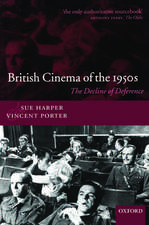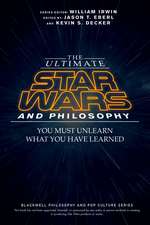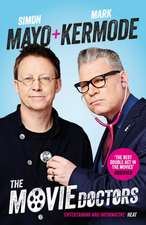Shots in the Mirror: Crime Films and Society
Autor Nicole Rafteren Limba Engleză Paperback – 25 mai 2006
Preț: 232.87 lei
Preț vechi: 262.84 lei
-11% Nou
Puncte Express: 349
Preț estimativ în valută:
44.57€ • 46.36$ • 36.79£
44.57€ • 46.36$ • 36.79£
Carte tipărită la comandă
Livrare economică 03-09 aprilie
Preluare comenzi: 021 569.72.76
Specificații
ISBN-13: 9780195175066
ISBN-10: 0195175069
Pagini: 288
Ilustrații: 20 halftones
Dimensiuni: 156 x 236 x 19 mm
Greutate: 0.41 kg
Ediția:Second.
Editura: Oxford University Press
Colecția OUP USA
Locul publicării:New York, United States
ISBN-10: 0195175069
Pagini: 288
Ilustrații: 20 halftones
Dimensiuni: 156 x 236 x 19 mm
Greutate: 0.41 kg
Ediția:Second.
Editura: Oxford University Press
Colecția OUP USA
Locul publicării:New York, United States
Recenzii
It's hard to imagine a more entertaining, well researched, and insightful encyclopedia of English-language crime films. Anyone who wants to know the history and place of crime cinema in the US should start here. Criminologist Rafter combines formidable analytic skills with a genuine love of the movies. Her well supported arguments help us to see many of them in new ways. Each chapter made me want to run out and look at films she discusses; but I didn't want to set the book down until I had finished it.
Shots in the Mirror is a book for scholars as well as for buffs by one who is clearly both. It is also a necessary book for students of crime and society as well as for students of film. In this new edition Rafter goes even more pointedly to the question of how crime movies `mirror' our world, reflecting the blank, the ambiguous and the unfinished, as well as the heroic and the villainous. I expect to use this book in my teaching, but mainly to devour it for my own pleasure and education.
Praise for the previous edition:"No serious studies have been conducted of how on-screen crime influences our perception of real-world crime. It is an ambitious topic, and [Rafter] handles it well in a very brief volume.... [She] concludes with a very interesting exploration of future social problems and how they may be played out on screen.... Food for thought on a very clever topic.
Brims with variety
Provides a brief survey that manages to range wider than other literature in the canon.... [Rafter's] strategy works well to fill a gap in the literature of 'criminological issues raised by movies.'
This book can help sociologists who want to know more about crime stories... A terrific resource book for crime movies as documents... The brief comparative accounts of scenarios and character portrayals provide a kind of cultural map about the language of justice, discourses of fear, and the significance of the criminal-as-other. Let us find ways to use such a fine resource to enliven our courses and research, to find ways to tell the right stories.
One of my favorite chapters (chapter 2) is the examination of the way in which criminologists drop discredited theories over time, but movies "recycle them" because they resonate with audience expectations that are measured by box office receipts.
Shots in the Mirror is a book for scholars as well as for buffs by one who is clearly both. It is also a necessary book for students of crime and society as well as for students of film. In this new edition Rafter goes even more pointedly to the question of how crime movies `mirror' our world, reflecting the blank, the ambiguous and the unfinished, as well as the heroic and the villainous. I expect to use this book in my teaching, but mainly to devour it for my own pleasure and education.
Praise for the previous edition:"No serious studies have been conducted of how on-screen crime influences our perception of real-world crime. It is an ambitious topic, and [Rafter] handles it well in a very brief volume.... [She] concludes with a very interesting exploration of future social problems and how they may be played out on screen.... Food for thought on a very clever topic.
Brims with variety
Provides a brief survey that manages to range wider than other literature in the canon.... [Rafter's] strategy works well to fill a gap in the literature of 'criminological issues raised by movies.'
This book can help sociologists who want to know more about crime stories... A terrific resource book for crime movies as documents... The brief comparative accounts of scenarios and character portrayals provide a kind of cultural map about the language of justice, discourses of fear, and the significance of the criminal-as-other. Let us find ways to use such a fine resource to enliven our courses and research, to find ways to tell the right stories.
One of my favorite chapters (chapter 2) is the examination of the way in which criminologists drop discredited theories over time, but movies "recycle them" because they resonate with audience expectations that are measured by box office receipts.













